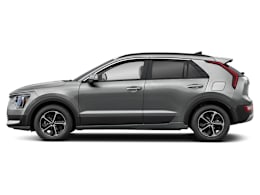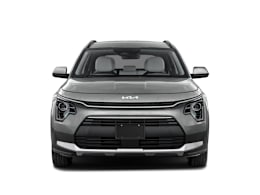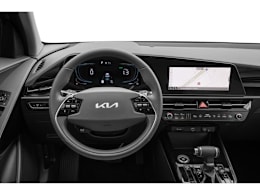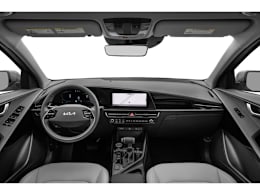The redesigned Kia Niro hybrid benefits from sharper handling, shorter stopping distances, and improved fuel economy. As before, its interior size and functionality rival that of a small SUV. Its biggest downside may simply be that it isn’t available with all-wheel drive, unlike most SUVs.
In our tests, the Niro hybrid achieved a superb 45 mpg overall, a 2-mpg improvement over the previous model. (We’ve also tested the Niro EV.) There’s a prompt and smooth electric surge from a stop, and if you step lightly on the accelerator pedal the Niro can propel itself on electric power alone at lower speeds. After that, the powertrain seamlessly blends its combination of electric motor and four-cylinder gasoline power.
We prefer the Niro’s six-speed dual-clutch automatic transmission over the continuously variable transmissions (CVT) found in most hybrids, because it delivers a more natural feel thanks to its smooth, conventional shifts. The 139-horsepower Niro is far from a speed demon, but with a 0 to 60 mph time of 8.9 seconds, it’s one-second quicker than the outgoing model, and it has more pep in its step than several of its competitors.
We didn’t like the steering’s slightly disconnected, rubbery feel, but it turns into corners responsively enough. Body roll becomes noticeable when you take a turn with some verve, which gives the car more of a mundane—rather than sporty—feel. Still, it showed impressive agility and secure handling through our avoidance maneuver test, aided by its modest size and weight. It posted competitively short stopping distances, too, which isn’t always the case with hybrids. The ride is mostly compliant, showing good absorption over smaller bumps, but the suspension gets overwhelmed by larger road imperfections, allowing bigger hits into the cabin in an unrefined way. Road and tire noise are pronounced, and the gas engine takes on a loud, grainy sound when quicker acceleration is called for.
For the most part we found the front seats comfortable; they offer a nice pocket to sit in, with adequate levels of lateral support to hold you in place through corners. But many drivers found they needed to adjust the steering wheel into an uncomfortably high position in order for the rim to not block the upper part of the rectangular instrument panel. The rear seat has a rather flat shape, but it has tons of headroom and plenty of foot space underneath the front seats; taller passengers might find themselves short on knee room.
The Niro’s upright stature strikes a nice balance between low-slung sedans and taller-riding small SUVs, which makes it easy to get in and out of. We also appreciate the airy forward visibility, which gives a good view of the road ahead. Unfortunately, the new “Aero Blade” rear roof pillars, in place of a third side window, make for huge blind spots back there. Kia says this design element allows air to slip between the pillar and the Niro’s body near the liftgate, aiding aerodynamics and, therefore, efficiency. Practicality is helped by the Niro’s hatchback design, which generously allowed us to fit four large suitcases behind the rear seats, and there’s a competitive 25 cu.-ft. of cargo space with the rear seats folded down.
Many of the Niro’s controls are straightforward and easy to use. But, like other recent Kia models, the split-use climate/media touchscreen-panel below the infotainment display is frustrating to use while driving. It requires toggling back and forth between the climate and media systems, which is annoying.
Two other versions of the Niro include more elaborate electrification: The plug-in hybrid (PHEV) has an estimated electric range of 33 miles before transitioning to regular hybrid operation; and the pure EV version, which we also completed testing, has an EPA-rated driving range of 253 miles.
Kia markets its active safety and driver assistance features under the “Kia Drive Wise'' banner. All Niro trims come standard with automatic emergency braking with pedestrian detection, automatic emergency braking which operates at highway speeds, blind spot warning, rear cross traffic warning, reverse automatic emergency braking, lane centering assistance, lane departure warning, lane keeping assistance, and automatic high beams.


























